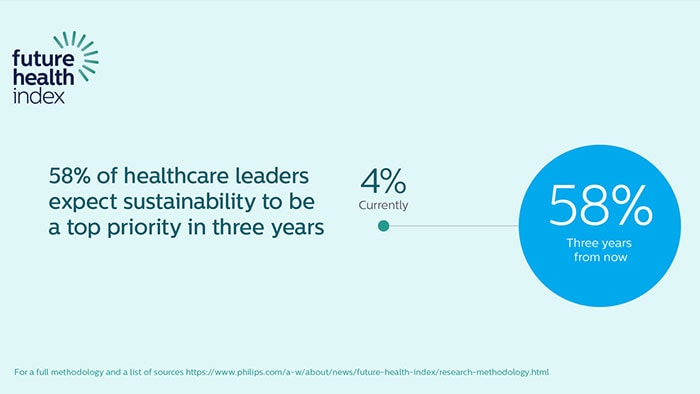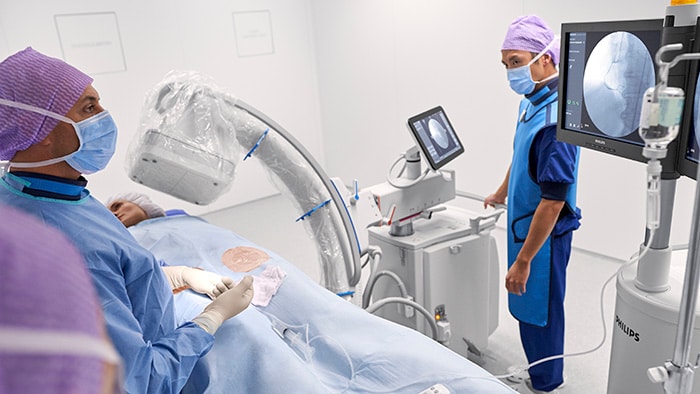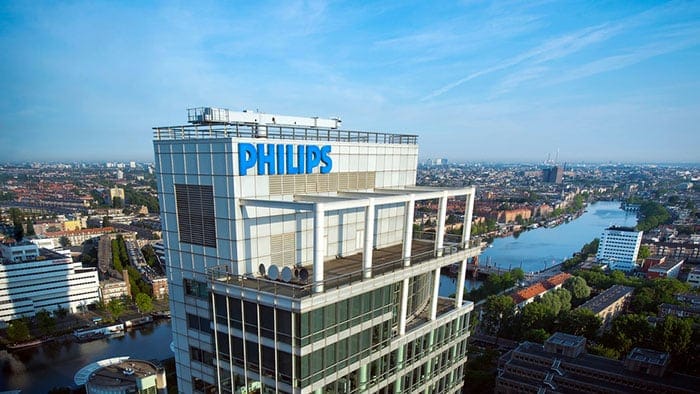When I – Jan Kimpen – was CEO of a large hospital in the Netherlands just over five years ago, I felt responsible for delivering the best care to our patients, and at the same time, responsible for implementing sustainable practices. But I never connected the two. We were front runners in sustainability in the Netherlands; we had one of the greenest servers in Europe, and solar panels on our roofs. We did all this to reduce waste, save money, and be a responsible company so that people would be attracted to work for us. Though like many healthcare leaders, I suspect, I never thought of sustainability as something that would improve the lives of the patients that came to our hospital, nor the doctors who cared for them. Since joining Philips I now see these elements as intrinsically linked. At our company, we look at sustainability through the lens of three of the Sustainable Development Goals (SDGs) of the United Nations: responsible consumption and production (SDG 12), climate action (SDG 13), and good health and well-being (UN SDG 3), which addresses the challenge of delivering high quality care to more people. At Philips, we see all three topics as interrelated. And yet, I still hear from medical leaders who struggle to see the correlation. They want to know why a patient would choose a hospital with sustainability credentials over one without, and why a doctor would choose to work at one. And so I got together recently with my colleague Robert Metzke, who is Global Head of Sustainability at Philips, to explore why sustainable hospitals deliver better care. Here are three reasons:
[When you see] the amount of trash produced by a hospital every day, you almost want to cry.
CEO of a hospital in Germany [1]
1. Caring for the planet = caring for your patients
Let’s start from the global perspective. Many of us are increasingly aware of the link between the waste we see in front of us and the effect it has on our planet. In its latest Global Risks report, the World Economic Forum emphasizes that the top five global risks to humanity in terms of likelihood are all related to the environment. Even before the pandemic, healthcare created a shocking amount of waste: a full 13kg per bed per day, according to one study [2], which is about the same weight as a car tire. And since COVID-19, doctors, patients, and everyday people alike have all noticed the monumental rise in single-use personal protective equipment [3]. In cities all over the world, discarded masks litter the streets. Rarely has waste become so tangibly connected to our health, which Robert and I believe may have encouraged health leaders to reflect on how to address such an urgent global crisis. Indeed, this theme came up when we interviewed healthcare leaders for the Future Health Index 2021 report [4]. In the survey, sustainable practices referred to “environmentally conscious sourcing, recycling, etc,” which correspond to SDGs 12 and 13. We were surprised and pleased to see an immense 15-fold increase in expected importance of environmentally sustainable healthcare from now to three years from now. Healthcare leaders told us that implementing sustainability practices in their hospital or healthcare facility will rise from the bottom of their priority list (4%) to the top (58%) in three years, with those in France (86%) and the Netherlands (81%) leading the way. As they plan for the future, one way in which hospitals are looking to implement sustainable practices is through their choice of partners. In particular, they see three sustainability actions as clear differentiators: long-lasting design of products (58%), circular economy business models (43%), and sustainable health and safety operations (40%) at a corporate level.
Caring for people and caring for the planet are two sides of the same coin. Sustainability needs to become an integral part of how care providers operate.
Robert Metzke
Global Head of Sustainability, Philips

2. Digital transformation enables sustainable care delivery models
Sustainability initiatives often go hand-in-hand with technology advancements, where switching to reusable items instead of single use offers environmental benefits and cost savings. Spurred by the pandemic, healthcare leaders have also stepped-up adoption of digital technologies [5]. Indeed, digitalization is becoming a major catalyst for more efficient use of resources and a faster shift towards sustainable models of healthcare, including wider access to care (SDG 3). Telehealth capabilities help to improve the green credentials of hospitals by reducing patient travel at the same time as extending the reach of care for those who struggle to access it [6]. The Future Health Index 2021 report found that implementing sustainable practices was far more pronounced among healthcare leaders who work in (technologically advanced) smart hospitals or healthcare facilities (71% compared with 58% for digital and analog) and those in developed markets (65% compared with 52% emerging).
Investing in technology is investing in sustainability. I do not see them as separate.
Department Head of a Pulmonology Hospital, the Netherlands [1]
3. Better care pathways lower your environmental footprint
So far, we have explored how reducing the carbon footprint of healthcare requires direct action to reduce waste, increase energy efficiency, adopt circular practices, etc., as well as extend access. But it also requires the radical reform of care pathways. Many of you will already know that healthcare is one of the world’s most polluting industries; the combined emissions from hospitals, health services, and the medical supply chain across OECD countries plus China and India account for around 4% of global CO₂ emissions, which is more than aviation or the shipping industry [7]. We also know that the pandemic has created an immense backlog of patients [8]. This has triggered us to run a project at Philips looking into the correlation between reducing the length of stay of a patient and reducing the carbon footprint of each patient. Over time, we hope to gather more data relating to how better care contributes to lowering a hospital’s environmental impact. We’re analyzing impact along the entire care journey, from improving inpatient care, leading to earlier discharge, through to preventing readmission with virtual home care. Our aim is to understand exactly where the environmental impact is for the care provider, and then connect the capabilities to help care providers address them as early as possible.
If I were to go back to running a hospital again, I would be looking at ways to connect our sustainable practices with sustainable methods of delivering care.
Jan Kimpen
Chief Medical Officer, Philips
Acting now will bring the biggest benefits
As Robert has said before, if this past year has taught us anything, it’s how interconnected the social, economic and environmental challenges we face are. We both believe passionately that the challenges faced by the healthcare industry are equally interconnected, and that actively contributing to sustainable development is not only good for business, it is the only way to do business. As such, we call upon healthcare leaders to embrace sustainability on multiple levels – in operations, procurement, purchasing, maintenance and new models of care. We also call for more urgency. The Future Health Index 2021 report shows that healthcare leaders are looking to prioritize sustainability in healthcare facilities in three years. But I urge leaders to start sooner than that. If I were to go back to running a hospital again, I would be looking at ways to connect our sustainable practices with sustainable methods of delivering care today. Because I can see how they are both desperately needed to deliver better outcomes, lower costs, and better patient and staff experiences. So let’s join together, act now, and set ourselves on a more sustainable course for the future.
It’s indisputable that the efforts of caring for our earth and caring for our communities go hand in hand. As part of our mission, we have an ambitious goal to improve the lives of 2.5 billion people a year by 2030, while acting responsibly towards our planet at every step. Click here to learn more about how Philips is working towards a stronger, more accessible, and truly sustainable healthcare system in the U.S., and globally.
References: [1] Interviewed for the Future Health Index 2021 report [2] https://practicegreenhealth.org/topics/waste/waste-0 [3] https://www.nature.com/articles/s41415-020-2130-5 [4] Since 2016, Philips has conducted original research to help determine the readiness of countries to address global health challenges and build efficient and effective health systems. For details on the Future Health methodology and to access the Future Health Index 2021 report in its entirety, visit: https://www.philips.com/a-w/about/news/future-health-index.

Share on social media
Topics
Author

Jan Kimpen
Chief Medical Officer, Royal Philips Before joining Philips in 2016, Jan Kimpen, Professor of Pediatrics, was CEO of the University Medical Center in Utrecht. He leads the global clinical team of Philips, focusing on advocacy, customer partnerships, clinical research and medical consulting, and is responsible for the annual publication of the Philips Future Health Index. He is a strategic advisor for commercial and clinical strategy, market reimbursement, R&D roadmaps and partnerships and M&A, and provides thought leadership on relevant clinical and medical topics. Jan participates in the WEF Global Future Council on Healthcare, the American Heart Association alliance and the Board of Sanara Ventures in Israel. Jan is president of COCIR, the European trade union for imaging, healthcare informatics and radiotherapy.
Follow me on

Robert Metzke
Philips Global Head of Sustainability Mr. Metzke leads Philips’ activities in Sustainability where he drives the company’s strategy towards innovative, sustainable business models and embedding sustainable and circular ways of working across Philips. In particular, Robert and his team are leading all activities with regards to Philips' environmental responsibility, with a focus on climate action, circular economy and expanding access to healthcare in underserved communities, as part of Philips overall purpose to improve people's health and well-being. Before joining Philips, Mr. Metzke worked at McKinsey & Company as a consultant where he gained 5 years of experience in strategy and innovation in the high-tech, healthcare and public sectors. Mr. Metzke has a background in journalism, science publishing (Science/ AAAS) and academic research (physics). He is married, has three children and lives in the Netherlands.
Follow me on












